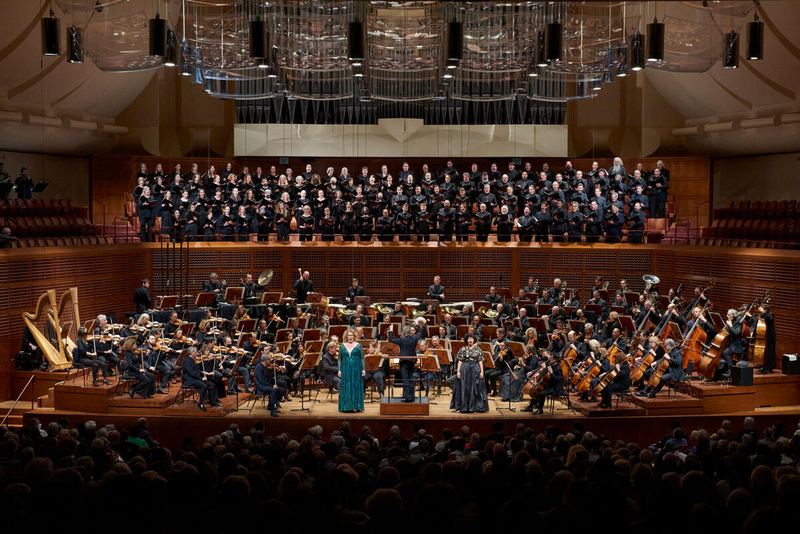
A LEAP INTO MUSICAL NIRVANA
Mahler’s “Resurrection” was a revelation, leaving us in the audience limp and giddy, as if, in a euphoric state of ecstasy, we had just been led through the Pearly Gates into the great beyond. And it was the finest hour yet for Maestro Esa-Pekka Salonen in the bows when the orchestra remained steadfastly seated, deflecting the cheers to the conductor himself. The audience too responded with an inordinate five-minute ovation for the San Francisco Symphony and Chorus et al for their rousing concert.
It was budget-be-damned Sept. 27 in a concert running 24 minutes beyond the two-hour norm, most likely unleashing overtime rewards for all concerned in the oversize ensemble.
Mahler’s Symphony No. 2 does require oversize forces—two harps, five percussionists, close to a score of brass players, with various brass sounding from off-stage sites above and outside the Davies Hall auditorium adding to a sense of some reimagined wonderworld.
The disappointment was that all this magnificence overshadowed a significant world premiere by Trevor Weston, “Push,” that had gone before.
The genius of Gustav Mahler lay not so much in the “Resurrection” choral-vocal text that he himself had penned in the late 19th century. It was in the entire 90-minute structure of a dozen moods culminating in that euphoric finale rivaling in impact Beethoven’s parallel Ninth Symphony (cum chorus) construct some 75 years earlier. In the build-up Mahler leads us through a welter of emotions of a very real life and world, overemotional yet precise in his scores: a serene sunrise on violins, then to the charming Austrian forerunner of the waltz called Lȁndler, to full-throated, exuberant outpourings on brass and percussion at deafening levels. It was an excitement akin to jumping off a high diving board willy-nilly hoping that the pool had water.
On the podium, Salonen paid inordinate attention to dynamics—not only loud, but also with some of the softest and most intimate sonics heard at Davies Hall. This was a throwback to unadulterated romanticism with visceral effect as rarely heard in our very rational 21st century. There came too the stimulus of pulse-quickening up-bows on violins, the bells-high positioning of French horns, and amazing crescendos. This was a quasi-religious experience comparable to high mass at a reverberent Gothic cathedral in Mahler’s own Bohemia-Austria habitats.
Much of the impact came from the 110 voices of the Symphony Chorus sounding out as rarely before under Salonen and guest chorus leader Jenny Wong. Just the male contingent alone had emerged with such robust strength that the walls of Davies may still be reverberating.
In far more restrained solos came soloists Michelle DeYoung and a newcomer from South Africa, Golda Schultz. One lamented that none of the night’s singing of consonants was well enough enunciated to enable following the German text in the printed program.
Almost lost in the night’s embers was the world premiere that went before, Trevor Weston’s “Push,” which deserved a better spotlight. Push refers to a Dvorak quote about Americans’ pushing the envelope in their endeavors. Though teaching on the East Coast, the 55-year-old Black composer has a considerable East Bay history, having earned his Ph.D. with the eminent late Prof. Olly Wilson at Berkeley, and having then associated with the Oakland Symphony’s late maestro, Michael Morgan, whose versatile involvement in so many facets of community music demands updating all the monographs on a conductor’s role. His deft threnody in the four-movement piece was dedicated to Morgan, who died last year at 63 shortly before his scheduled SFS debut.
(At times it was definitely tougher to make it as a Black musician, whether Morgan, Wilson or Weston. In 1975 I heard the 17-year-old ill-attired Morgan in a young conductors competition of the Baltimore Symphony, leading a Brahms movement, competing against all-white competition typically five years older, with diplomas from leading institutions. I heard Morgan give an electric reading, evoking play surpassing anything from the other candidates. However he only got an honorable mention, with a music prof citing to me Morgan’s crude stick technique!)
Weston demonstrated an apt versatility, ranging from pop-jazz influences to subtle orchestral expressiveness. The latter was also evident in his subdued “City Quiet” segment hovering somewhere between Copland and Bartok in pianissimos. The outer movements were boisterous, punctuated by effusiveness akin to John Coltrane, whom Weston could only hear on recordings, as tenor saxist Coltrane had perished at age 40 the year Weston was born.
MUSIC NOTES—The SFS’ new principal cellist, Rainer Eudeikis, performed in the first chair. Among the remaining unfilled principal chairs are flute and harp, with substitutes filling in each time.
TREVOR WESTON’S 20-minute world premiere “Push;” Mahler’s Symphony No. 2 with the S.F. Symphony and Chorus. Esa-Pekka Salonen, music director, at Davies Hall, San Francisco, through Oct. 2. For SFS info, call (415) 864-6000, or go online: www.sfsymphony.org.